This was published 7 years ago
The world's most mysterious travel destinations
By Sue Williams
In a jungle clearing there is a stunning sight that inspired one of the most legendary voyages in history.
From the moment famed Norwegian adventurer Thor Heyerdahl glimpsed a set of massive stone carvings standing grandly on a platform in a secluded valley of the most isolated islands in the world, he became obsessed with trying to find out who had put them there.
And today, those enormous tiki on Hiva Oa, one of the Marquesas Islands in French Polynesia, lying between Tahiti and Mexico, are no less breathtaking, and certainly no less of a mystery.
"They stared at us from the thickets with round eyes as big as lifebelts and grotesque mouths drawn out in diabolical grins wide enough to swallow a human body," Heyerdahl wrote in the 1930s of his first encounter after being told about them by a foreigner who had settled nearby after deserting his ship. "…who put these red, stone colossi there, and how? They must have weighed many tons."
That whodunit came to consume Heyerdahl. The stone wasn't quarried on the island, and none of the residents had any idea who might have had the skills to fashion them, or where they had come from.
As a result, in 1947, he launched his Kon-Tiki expedition, sailing 8000 kilometres across the Pacific in a hand-built raft from Peru to French Polynesia in an attempt to show it was possible and to prove South Americans had settled the islands and put them there. In so doing, he began a debate about the origins of species that is still far from over.
Some say Merlin brought the stones from Ireland to build the magic stone circle.
While we now have so much scientific knowledge and so many cutting-edge techniques, the world still contains some monumental mysteries that defy all logical explanation.
In Peru, vast patterns lay scoured into the sands of the Nazca desert that many once believed may have been drawn by visitors from another planet in ancient times. In Britain, Stonehenge is billed as its greatest Stone Age mystery and has been touted as having been built by the wizard Merlin or set up by an alien power as a UFO landing ground, among other theories. In Africa, some believe the medieval ruins of Great Zimbabwe are the remnants of the city built by the biblical Queen of Sheba.
Meanwhile, much closer to the modern day, some of the best minds in the world – as well as many of the more average ones – are still brooding over the Kryptos sculpture, a 3.6-metre high cryptic puzzle erected in the grounds of the CIA's headquarters in Virginia, US.
But pondering these mysteries helps make travelling to these sights, and destinations, even more fascinating.
STONEHENGE, UK
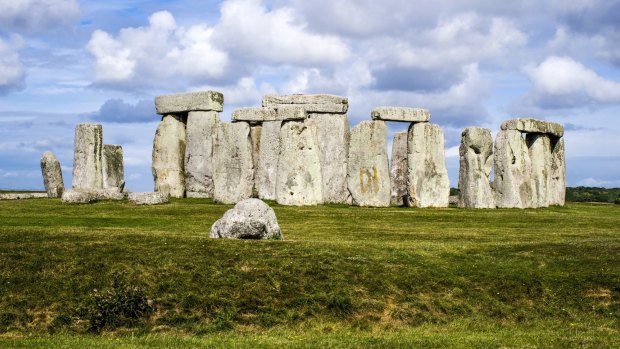
Credit: Getty Images
A magnet for mystics from all over the world, the prehistoric stone monuments of Stonehenge have long been believed to possess great spiritual powers. Every summer solstice, the longest day of the year in the northern hemisphere, believers – Druids, pagans and fun-seekers alike – gather to greet the sun in ceremonies as varied as they can be bizarre.
Built on the Salisbury Plain, about 140 kilometres south-west of London, Stonehenge is thought to have been built in stages from 3000BC, and is still one of England's most popular tourist attractions and one of the great wonders of the world.
Theories abound. Some say Merlin brought the stones from Ireland to build the magic stone circle, some say it's a great base for UFOs, others hold that it's an ancient calendar, an astronomical chart or a place for worshipping the sun.
Alternatively, its wonderful acoustics could be a clue to a past as some kind of meeting and discussion place, or it could have been a burial ground, with tombs uncovered near the site. Then again, some believe it to have been a destination thought to have special healing powers, with some of the buried skeletons found to have come from far away.
The latest theory from scientists is that Stonehenge could even have been built as a symbol of peace and unity, a kind of Stone-Age twin towers, marking the end of traditional regionalism with the building, and incredible engineering, of the site requiring the work of thousands with some stones brought from as far away as Wales.
These days, you can no longer wander within the stone circle, but you can walk around it and he visitors' centre has an audio-visual display showing what it looks like, including during the winter and summer solstices.
Considering it's still such a mystery, it's a very well developed attraction with a great deal of information. Neolithic houses have been constructed, showing how people would have lived 4500 years ago, there are regular demonstrations of traditional skills such as grinding grain and fashioning rushes into ropes, there's an exhibition currently on with more than 250 archaeological objects discovered in the landscape, and there are many volunteers eager to share their knowledge – and theories – with visitors.
Getting There: All of the major airlines operate frequent flights between Sydney and Melbourne to London. See qantas.com.au; virginaustralia.com; emirates.com. There are frequent trains from London Waterloo to Salisbury (1.5 hours) with a connecting Stonehenge Tour bus thestonehengetour.info or there are day bus trips from London, taking about 2½ hours to get to Stonehenge. It's best to book entry tickets in advance, online english-heritage.org.uk.
Highlights: As well as Stonehenge, you can't miss visits to the Tower of London, Windsor Castle, the changing of the guard at Buckingham Palace – and a peek inside, when it's opened in August and September each year, Alnick Castle in Northumberland, home of Harry Potter's Hogwarts, and Stratford-upon-Avon, the birthplace of Shakespeare. visitbritain.com
TIKIS ON HIVA-OA, THE MARQUESAS ISLANDS
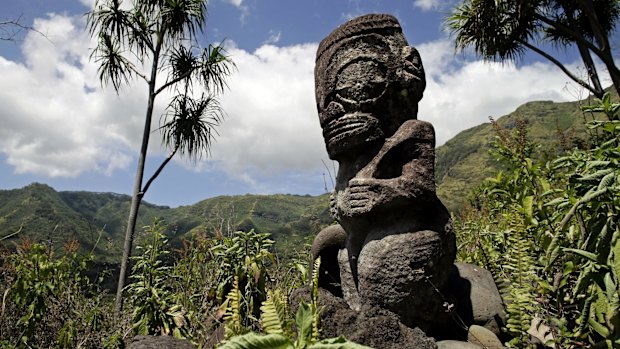
Credit: Getty Images
On the site of a temple once used for cannibal festivities, French Polynesia's largest tikis stand in the sunshine. Once, they were covered by the creepers and vines of the surrounding dense rainforest. Now they've been cleaned and are back surveying their kingdom like the ancient ancestor gods of the valley they're widely supposed to represent.
Carved in rage-red stone, they're almost twice the height of a person and more than twice as wide, and they've been bewitching visitors since the first European ethnologist arrived to examine them in 1897.
These simple but enormous figures seem to dare anyone to come too close. The largest is a stunted man with a giant head and a fierce expression, while a female figure sits close by. This could be his wife – or one of his wives since polygamy was widely practised then. Another is of a woman lying on her stomach, popularly believed to be in a representation of childbirth.
What is equally bewildering is that the tiki are growing in height. Some suppose that everything under the rock platform they're on is growing, lifting them up. Others say it shows their mystical power is strengthening.
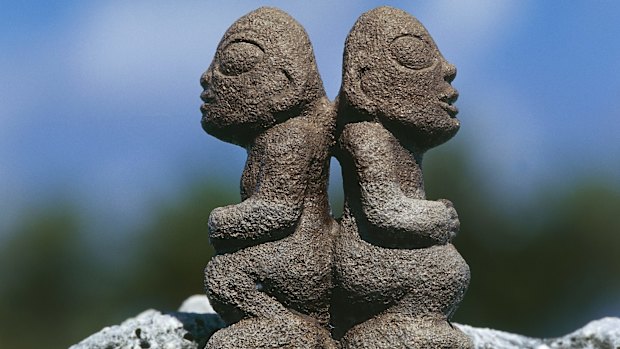
Credit: Getty Images
Heyerdahl noted some similarities with the massive, and much better known, statues of Easter Island, and ended up surmising they were anthropological proof that Polynesia was settled first from South America. Later DNA evidence has shown the first inhabitants are more likely to have migrated from Taiwan, but there are still signs that there may have been some visitors from the Americas, with the popularity of the sweet potato in both places.
Back in Heyerdahl's day, the tikis at Te I'lpona were reached by a long trek through the jungle, but today they are much easier to view. While there are parts of each of the Marquesas' interiors that remain unexplored, there are now good roads around the steep volcanic banks, and often down into the craters, too. Te I'lpona is a short drive from the Puamau Pier on the north-eastern coast.
Getting There: The best way is aboard the freighter-cruiser the Aranui 5 which operates 14-day voyages from Tahiti around the Marquesas. Fly Air New Zealand to Auckland, then Air Tahiti Nui to Papeete, the Tahitian capital. It costs from $8689 a person twin share for a 17-night package including the cruise, excursions and flights. Ultimate Travel Phone 1300 485 846, see aranuicruises.com.au.
Highlights: As well as the tikis, Hiva Oa is famous as the home of painter Paul Gauguin and Belgian singer Jacques Brel, both of whom are buried at the nearby cemetery. The Marquesas themselves are astonishingly beautiful: tall mountains, and white beaches. The locals are eager to keep alive their traditional arts, crafts, songs and dance.
See also: How to get to the world's most remote paradise
THE NAZCA LINES, PERU
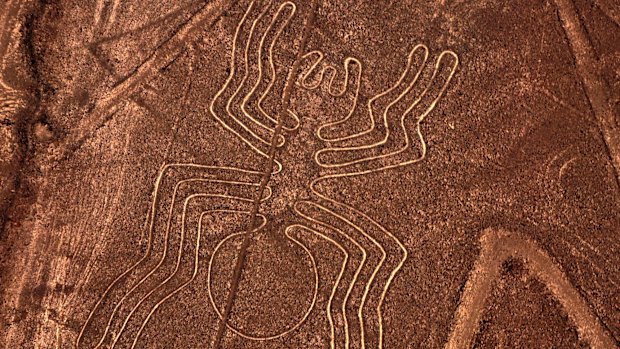
Credit: Getty Images
Soaring in a tiny plane over the rose desert sands of Nazca, 320 kilometres south of the capital Lima, there is a wondrous view of the hundreds of giant images scratched into the earth.
From the ground, it's impossible to appreciate their magnitude but, from the air, an incredible kaleidoscope of pale drawings of animals, birds, plants and intricate geometric designs gradually emerges over a site covering about 1000 square kilometres.
Look! There's a hummingbird. And here's a monkey with a fabulously curling tail. A pelican flaps its wings with a span of over 300 metres. One straight line continues, absolutely unwavering, for 14.5 kilometres into the distance.
The mysteries are manifold. How did these images get here? Who drew them, and when? How could they possibly have been so accurate over such incredible distances? And, perhaps most intriguingly of all: why?
The theories have been just as varied. Erich von Daniken wrote the bestselling book, Chariots of the Gods?, claiming they were placed there by visitors from outer space. Others have purported the lines are astronomical charts, pathways between shrines or a map of underground water sources, with ancient aqueducts.
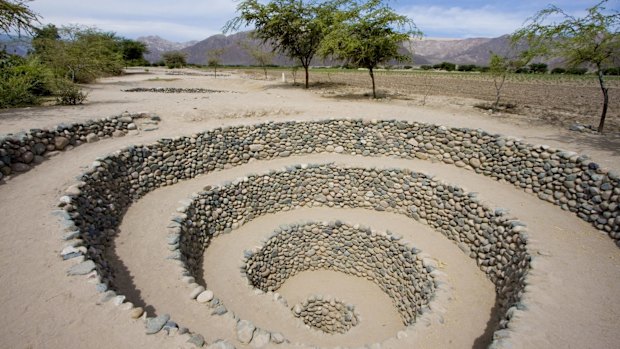
Credit: Getty Images
The late Maria Reiche, a German archaeologist and mathematician who lived by the lines from the 1940s, researching them and guarding them – even having a tower built nearby for visitors to climb up to view them – believed the lines, thought to date from 200BC, represented a giant sun calendar. In 1995, they were declared a UNESCO World Heritage Site.
They're an awe-inspiring sight and best way to view them is from a small plane.These planes are not always comfortable; they are hot and the ride is often bumpy with the warm air from the sun-burnished desert below creating strong currents, particularly as the day progresses, and the pilots steer figures of eight and tilt the planes for the best views. All the planes carry sick bags.
The memory of those lines stay scarred on visitors' memories just as they do on the desert sands below.
Getting There: Qantas flies direct to Santiago, Chile with connections via LAN Airlines to Lima, Peru. Both tourist and local buses go straight to Nazca (about six hours), or hire a car, or a car with driver. There are also tours from Lima. Flights over the lines cost about $80 and can be booked at Nazca.
Highlights: As well as the lines, there's the lost Inca city of Machu Picchu, the golden city of Cusco, a slow boat down the Amazon from Loreto, Lake Titicaca from Puno, the highest commercially navigable lake in the world, the sand dunes of Huacachina, and the Husascaran National Park, with lakes, rivers, glaciers and wild animals. peru.travel/en-au/.
See also: South America: A first-timer's guide
GREAT ZIMBABWE, ZIMBABWE
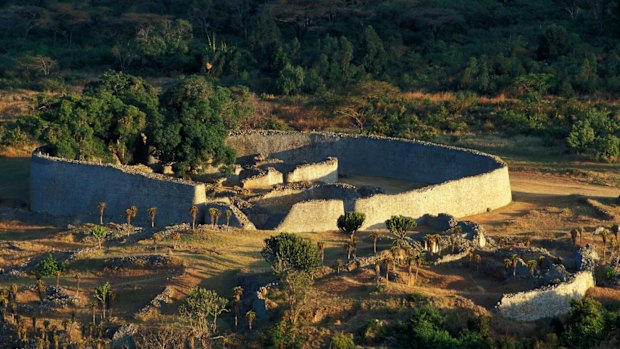
Credit: Alamy
When people refer to the Acropolis, do you think of Athens? Well, think again. The Acropolis of Great Zimbabwe may not be quite so visually stunning, but it has a rich history, and an absolute wealth of fables surrounding it.
The ruins of the old city, a national monument from which the name of the country comes and the largest set of ruins in sub-Saharan Africa, cover an area of almost 80 hectares near the town of Masvingo, 290 kilometres south of the capital Harare, and are thought to date to the 11th century.
In the early 16th century, when they were first chanced upon by Portuguese explorers, they were written about as "the work of the devil, for … it does not seem possible to them that they should be the work of man".
Later, in the 1860s and 1870s, they were thought to be a possible palace of the Bible's Queen of Sheba and King Solomon. A wooden lintel on the site was said to be Lebanese cedar, brought by the Phoenicians, with the palace thought to replicate the one in Jerusalem.
Others claimed the builders had been either those Phoenicians from the Mediterranean coast around what is today Syria, Lebanon and northern Israel, or Arabs. Although everyone now knows they were built by the indigenous Shona people, in the Rhodesia of the 1960s and 1970s, the white Government even censored any archaeologists who said Great Zimbabwe would have been built by black Africans, wanting always to portray them as an inferior race incapable of such a feat.
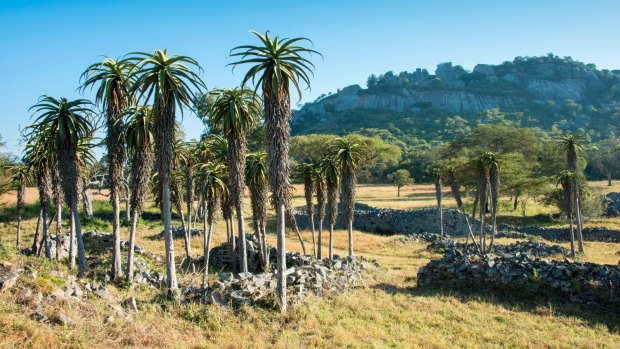
Credit: Alamy
While the mystery of the city continues, it's thought that it was once an important trading area, famed during the Middle Ages and afterwards, with beads, porcelain, gold and coins found at the site from as far away as China and Persia. A granite cross could have come from Western missionaries.
Now its Acropolis, on a hilltop, are a mass of granite blocks forming enclosures and passageways, thought once to have been the royal part of the city, home to successive kings and chiefs. To the south is The Great Enclosure, with living quarters and a conical tower while the ruins in the valley are of other homes.
In the 14th century, it was the capital of a flourishing state with a population of more than 10,000, living on the gold-rich plateaus. It's thought to have been abandoned in 1450 because of food shortages. At the site, there's a museum and cultural village with traditional crafts and dancing, and local guides for hire.
Getting There: A combination of Virgin Australia and South African Airways fly to Harare via Perth and Johannesburg, while Etihad and Kenya Airways fly via Abu Dhabi and Nairobi. In Harare, there are plenty of car hires, and it's a four-hour drive to the ruins on the main route to Johannesburg.
Highlights: Apart from Great Zimbabwe, there are the Victoria Falls on the Zambian border, "the smoke that thunders", the magnificent falls with the world's largest sheet of falling water, sunset cruises on the Zambezi, Mana Pools with its wealth of wildlife and Lake Kariba with its fishing, canoeing and game drives. zimbabwetourism.net.
See also: Africa's new frontier for safaris
KRYPTOS, VIRGINIA, US
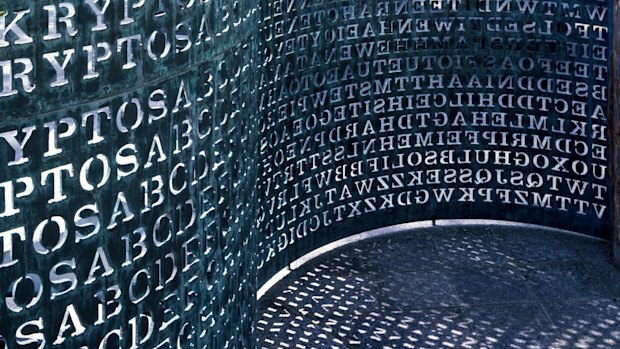
Credit: Getty Images
It's the most puzzling of modern mysteries: a sculpture created for the CIA headquarters in Langley that nobody but its creator has been able to decipher.
American artist Jim Sanborn finished the Kryptos sculpture in 1989, the year the Berlin Wall began to fall, and unveiled it in 1990. A 3.6-metre-high artwork of wood, granite and copper with about 1800 letters carved into the copper plate, it contains four encrypted messages.
Three have been solved, but the fourth remains an enigma, one of the most famous unsolved codes in the world.
Last year, Sanborn released a second clue to mark both the 25th anniversary of the fall of the Berlin Wall, and his 69th birthday. So far, however, no one has come any closer to unlocking the riddle, a secret kept by just 67 letters.
And even those who thought they knew, probably don't. Sanborn allegedly gave all four answers to two people, the former chairman of the CIA's Cryptographic Centre Ed Scheidt, and former CIA director William Webster. Later, however, Sanborn said he hadn't given them the right answers …
Kryptos continues to excite interest far beyond its creator's dreams. Dan Brown's bestselling novel, The Da Vinci Code, has two references to Kryptos, and it appeared in the TV shows Alias and Homeland.
Getting There: Qantas flies direct to Dallas then Delta flies to Richmond, the capital of Virginia, via Atlanta. From there, you can catch a bus, train or it's a two-hour drive.
Highlights: Apart from Kryptos, Virginia has a host of other attractions, including The Arlington National Cemetery, the African-American heritage trail, winter sports, Smithsonian National Air and Space Museum, the Robert E. Lee Memorial, Washington National Monument Park, Historic Jamestowne. virginia.org.
See also: Inside the museum that hates America
FIVE MORE GREAT MYSTERIES
MACHU PICCHU, PERU
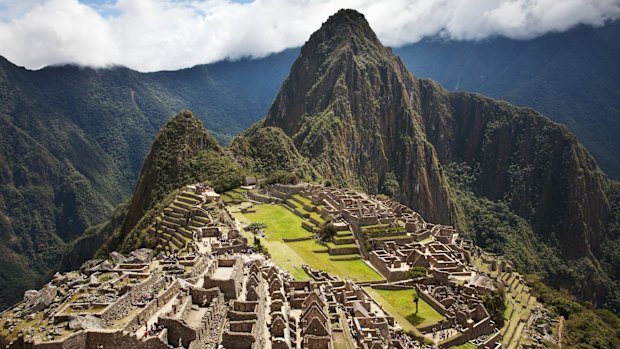
Credit: Getty Images
Although the site was discovered high up in the Andes more than 100 years ago, no one knows why, and how, it was built. The Inca had no writing and so left no discernible records explaining why it's there, and why it was later abandoned.
PYRAMIDS, GIZA, EGYPT
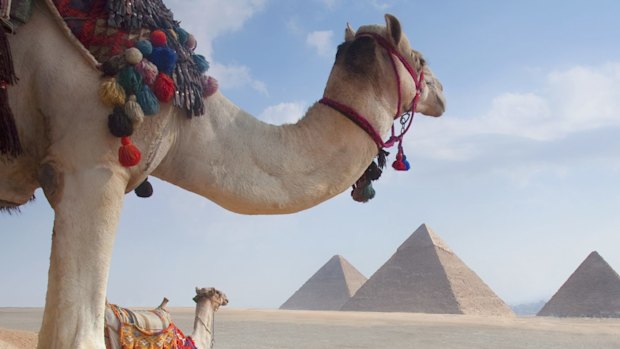
Credit: Getty Images
They're the best known structures of the ancient world, yet there's shockingly little known about their construction and their purpose. Many theorise that they're funerary structures of kings, but no evidence has ever been uncovered to support the myriad theories.
THE TERRACOTTA ARMY, XIAN, CHINA
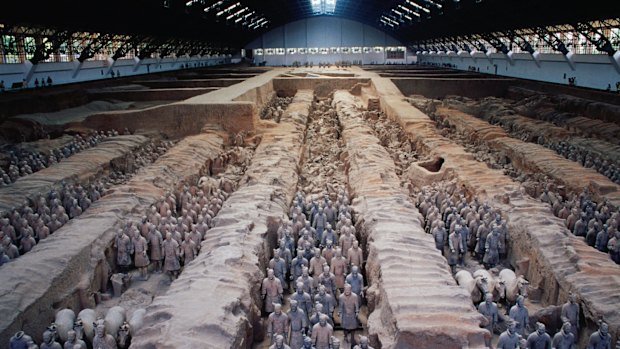
Credit: Getty Images
One of China's top attractions, the hundreds of clay life-size models, discovered in 1974, are said to represent an army from 2200 years ago, meant to protect Emperor Qin Shi Huang in his journey to the after-life. But with each figure quite different, scientists are still trying to discover whether they were all based on a single template – or on the real members of the army.
THE ARK OF THE COVENANT
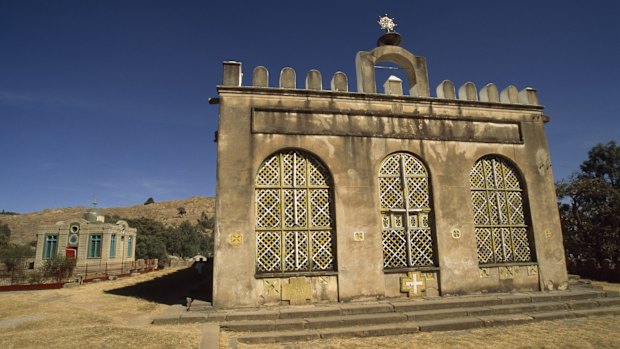
Credit: Martin Gray
Spoken of in the Bible, and presented to a whole new generation by the movie, Raiders of the Lost Ark, the wooden chest inlaid with gold containing the Ten Commandments carved in stone has since disappeared. But there are many theories about where it might be. Possible locations include Mount Nebo, south of Jerusalem; a church in Axum, Ethiopia; in a cave in the Dumghe Mountains in South Africa; Chartres Cathedral, France; and at a family estate in Warwickshire, England.
ROSSLYN CHAPEL, ROSLIN, SCOTLAND
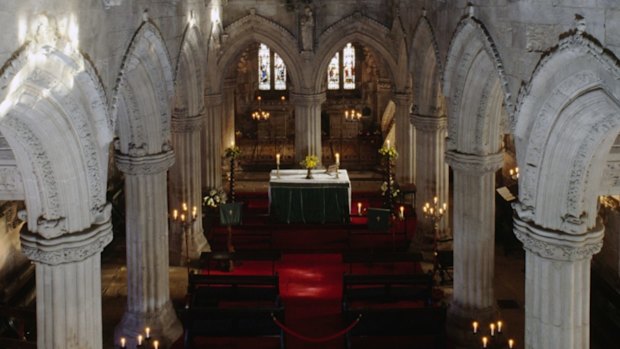
Credit: Getty Images
The 15th-century chapel, 10 kilometres south of Edinburgh, became known around the world after appearing at the centre of The Da Vinci Code's conspiracy theory as the place that houses the Holy Grail, the skull of John the Baptist, Mary Magdalene or a dozen armed Knights Templar. It's thought they could be buried beneath the church.
See also: 10 of the world's greatest World Heritage sites
See also: Secret spots: 10 places you will never visit
Sue Williams travelled to the Marquesas Islands as a guest of Aranui Cruises, Air Tahiti Nui and Tahiti Tourisme.
Sign up for the Traveller Deals newsletter
Get exclusive travel deals delivered straight to your inbox. Sign up now.